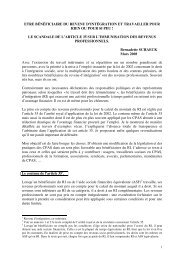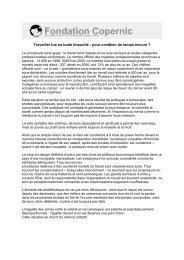Awra Amba RJ 300612 EN - Contacter un comité local d'Attac
Awra Amba RJ 300612 EN - Contacter un comité local d'Attac
Awra Amba RJ 300612 EN - Contacter un comité local d'Attac
You also want an ePaper? Increase the reach of your titles
YUMPU automatically turns print PDFs into web optimized ePapers that Google loves.
4. Social organisation<br />
20 birrs), and built and rents a house to teachers and another to schoolboys coming from far away<br />
(Crespo, 2011; 2012).<br />
Picture 9:<br />
The village square, with on the left the big tree for meetings and in centre the grocery<br />
shop; The village the grocery shop in January 2011 (pict. C. Crespo).<br />
Globally, handcraft (spinning and weaving) is the main occupation for almost everyone (98 %),<br />
farming the second occupation for 94 % of interviewed people, and trade the third occupation for<br />
74 % of interviewed people (Ya08/99). Mekonnen (2009/38) states that subsistence agriculture<br />
constitutes the main source of income, whereas for Jo10b/7, weaving is the main source of income of<br />
the cooperative, followed by trade, then milling, finally the truck. The share of the various sources of<br />
income is therefore not very clear (Question 22 in Annex).<br />
Picture 10: Small house, exceptionally ro<strong>un</strong>d, with its private loom, in 2010.<br />
Mekonnen (2009/38) mentions also other activities such as beekeeping and the production of energysaving<br />
stoves and other household utensils, using <strong>local</strong> materials and <strong>local</strong> technology. Weaving of<br />
traditional clothes known as shemma is also practised by all with a family loom (Picture 10) and<br />
provides a significant source of income during the dry season; every family gives 11 birrs a year for<br />
its supply of cotton (Crespo, 2011). The families raise in addition hens, grow a few vegetables; some<br />
produce honey; others have a zebu in the herd of the village and sell the milk in the coffee shop.<br />
Since 2011-2012, the cooperative experimented cultures on compost with the help of Oromo<br />
specialists (0.5 m 2 mini-gardens, vegetables on the sides of compost bags) and egg-laying hens with<br />
advice of the government, whose food was bought (Crespo, 2012).<br />
47 / 85

















